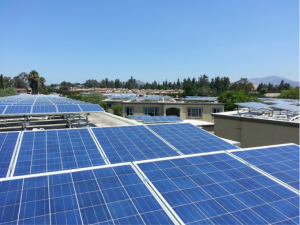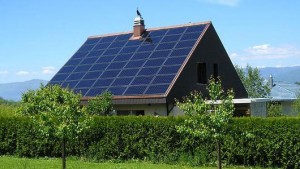/cdn.vox-cdn.com/uploads/chorus_image/image/55614127/rooftop_solar.0.jpg)
California regulators are in the process of revising the state’s incentives for rooftop solar installations and other small-scale renewables. The current incentives, known as “net energy metering,” compensate local producers for surplus energy fed back into the grid with a full retail credit, rather than a less-expensive wholesale or “avoided cost” rate.
Ratepayer advocates believe this full retail credit is a subsidy for wealthy homeowners who disproportionately have rooftop solar, while some environmental and solar groups argue they are a necessary tool to achieve California’s ambitious climate agenda and promote economic growth.
We’ll hear a debate tonight on the state’s approach to subsidizing this type of renewable energy tonight on State of the Bay at 6pm PT. Joining us will be:
- Severin Borenstein, Director of the Energy Institute at Haas School of Business
- Loretta Lynch, former President of the California Public Utilities Commission
Plus, as the Bay Area starts to emerge from the pandemic, will hunger finally subside? Tanis Crosby, Executive Director of the San Francisco Marin Food Bank, we’ll give us the latest.
And finally, we’ll hear from State of the Bay frequent contributor Lara Bazelon, Director of the Criminal and Juvenile Justice and Racial Justice Clinics at the University of San Francisco School of Law, about her new novel, “A Good Mother.”
Tune in tonight at 6pm PT on KALW 91.7 FM in the San Francisco Bay Area or stream live. Call 866-798-TALK with questions during the show!
Energy economists don’t like rooftop solar. Depending on the policy involved, it can entail significant and cost-inefficient ratepayer subsidies. For example, Lucas Davis at UC Berkeley’s Energy Institute at Haas recently calculated that non-rooftop solar customers are paying $65 per year to subsidize solar customers. He got this number by taking the difference in price between a retail credit for every kilowatt hour delivered from a rooftop solar customer to the grid and the wholesale price that this electricity actually costs.
In California, the average retail electricity price is about $0.18/kWh, while wholesale rates are close to $.04/kWh. That means that utilities are losing about $.14/kWh for each retail credit they give rooftop solar customers for their surplus solar (since they could have purchased the electricity for much cheaper elsewhere). And since utilities have a lot of fixed costs sunk in grid infrastructure, Davis was able to calculate the total subsidized amount spread over non-rooftop solar customers and divide it by ratepayers to arrive at the $65 per year in ratepayer cost-shifting.
Ultimately, it’s that cost-shifting that explains why energy economists like Davis and Serverin Borenstein hate California’s new solar rooftop mandate so much.
But this cost-shifting doesn’t have to happen — it’s due specifically to electricity rate policies. And in that respect, Hawaii tells a different and more promising story. Ultimately, I believe that state’s rooftop solar policies are where California is headed soon.
In Hawaii, utilities stopped offering full retail credit for surplus rooftop solar back in 2015. Instead, they essentially pay solar customers the wholesale rate for their surplus. As a result, utilities aren’t losing what would be $.14/kWh in California for each retail credit they give. So no cost-shifting happens.
And the impact on the ground for Hawaii rooftop solar customers? Homeowners are still ordering solar panels, but now home battery installations are starting to take off, too, as this state government chart from Utility Dive shows:

To be sure, it’s still relatively early days of the policy and the on-the-ground response. But given plunging battery prices, as well as cheaper solar installations, this solar-plus-battery technology solution seems like a great way to address complaints about cost-shifting and ratepayer subsidies. It also points to a path forward for the rest of the country, with a future of rooftop solar on most homes — and batteries in every basement or garage.
The upside is more clean technology deployed, a bigger market to bring down costs further on solar and home energy storage, reduced greenhouse gas emissions, and improved grid resilience in the case of extreme weather or other disasters. Not a bad deal all around, and one California will probably eventually see as well, as its rooftop solar policies evolve.
Most electric utilities hate rooftop solar. When a customer installs solar on their roof, it means fewer sales (and therefore revenue) for the utility. It also means more unpredictable and dispersed sources of power from rooftops everywhere. As a result, many utilities across the country have been trying to kill state rooftop solar incentives for years.
 I’ve covered the battles in states like California, Hawaii and Nevada on this blog. The short of it is that California has slightly decreased their incentives for rooftop solar, in the face of declining prices and concern about utility costs; Hawaii has retrenched significantly but in turn created a new market for home batteries + solar; and Nevada brutally ended their incentives a year ago, leaving even existing solar customers without incentives that they had relied on when they bought their panels.
I’ve covered the battles in states like California, Hawaii and Nevada on this blog. The short of it is that California has slightly decreased their incentives for rooftop solar, in the face of declining prices and concern about utility costs; Hawaii has retrenched significantly but in turn created a new market for home batteries + solar; and Nevada brutally ended their incentives a year ago, leaving even existing solar customers without incentives that they had relied on when they bought their panels.
But the end of 2016 brought some significant updates for Nevada and now a new state, Arizona. First, as Greentech Media reported, Nevada regulators have restored the incentives for customers in the northern utility service territory (after having previously given into public pressure and restored the incentives for existing customers to “grandfather” them in).
But Arizona regulators have decided to jump off the rooftop solar cliff, killing existing incentives (which involve a full retail credit for every surplus kilowatt of electricity generated by the panels and not used on-site). Instead, solar customers in Arizona will be eligible for a vastly reduced and unpredictable “export rate” for any surplus electricity generated. As the Arizona Daily Star described:
The export rates will be determined in each utility rate case and will initially be based on a “resource comparison proxy” based on a weighted, five-year average cost of power from utility-scale solar farms.
The new export rates will vary by utility and be stepped down annually, in increments limited to 10 percent each year.
Solar industry advocates are already predicting that their industry will die in Arizona, as they correctly predicted would happen in Nevada after incentives were killed there, too.
Once those jobs disappear and Arizonans realize what they’ve lost, especially given that the state was otherwise one of the best-selling markets for solar with its abundant sunshine and high air conditioning bills, expect major political pushback. I wouldn’t be surprised if we see a Nevada-like reversal in the coming year or so.
In the meantime, the big winner could be battery companies like Tesla. Per Bloomberg, as the company “flipped the switch” yesterday on its gigafactory in Nevada, it will potentially have a new market to sell its product.
Why? Because if solar customers in Arizona aren’t going to get paid much for their surplus energy anymore, they’ll be interested in a cheap battery that can store that surplus and help them use all of it on-site. The battery therefore allows them to effectively recreate that full retail credit they used to get under the old system: any electricity they would have had to purchase from the utility when the panels weren’t producing or producing enough, they can now get from their battery.
So while states lurch around on their rooftop solar policies, the long-term trend seems clear: the incentives are decreasing, and cheaper batteries will be filling that void.
Hawaii and Nevada represent two states pioneering a “post-net metering” world for rooftop solar. Collectively, they’re providing some interesting learning experiences for the rest of the country.
Many other states have traditional net metering, in which any surplus rooftop solar energy you produce for the grid is credited at a full retail rate on your bill. But Hawaii and Nevada utilities have successfully pushed back on that approach, convincing state regulators to diminish or even gut the incentives.
 First, Hawaii: the state has significant rooftop solar uptake, with a nation-leading 17% of all customers in the main utility’s service territory. But the utility there has been trying to fight further proliferation with the usual arguments related to reliability and cost.
First, Hawaii: the state has significant rooftop solar uptake, with a nation-leading 17% of all customers in the main utility’s service territory. But the utility there has been trying to fight further proliferation with the usual arguments related to reliability and cost.
The state’s regulator has largely followed the utility line, ending net metering and replacing it with two options. The first is a fixed rate payment for surplus power that is less than the full retail credit, called a “grid supply” option. The second is a “self-supply” option that features a minimum bill and only some surplus power allowed back on the grid.
Perhaps not surprisingly, the fixed rate “grid supply” option has been the most popular. But regulators imposed a cap on that program, which the islands have already started to bump up against. As a result, solar companies are lobbying hard for regulators to raise the cap. But even if they raise the cap, the long-term problem isn’t going away.
So that’s why it’s interesting to see the market in Hawaii respond with technology packages to help spur demand for the self-supply option. As Utility Dive reports:
Other solar developers like Sunrun and SolarCity have rolled out offerings aimed at the CSS [self-supply] option. SolarCity’s product is a combination of storage, solar systems and a Nest thermostat, water heater and controller, allowing consumers to use more of their energy onsite.
The savings are significant, according to Mark Dyson from Rocky Mountain Institute. By using the product, customers could “save 33% on their electricity bill, “which amounts to “nearly 80% of the savings that the old NEM arrangement offered.”
Sunrun’s Brightbox is another option. The company teamed up with Tesla to offer solar-plus-storage system, a much simpler one than SolarCity. While the first Brightbox installation occurred earlier this year, the company plans to roll out this offering in full force before the end of the year.
Both offerings could receive a boost if a group of energy storage bills reappear in the next legislative session, bringing down the cost of storage installation through extending tax credits, offering rebates or both.
So in Hawaii, we may end up seeing a combination of smart new policies and technology and financing packages that can make a post net-metering world viable there for distributed clean technology.
Nevada, meanwhile, is pulling back from the brink a bit. The state’s electricity regulators had previously yanked all solar incentives — not just for new customers but for existing ones that already plopped down thousands of dollars (in some cases) for rooftop PV.
But now a deal seems to have been worked out to soften the harsh retrenchment. Per the Reno Gazette-Journal:
NV Energy reached an agreement with the Public Utilities Commission of Nevada, Bureau of Consumer Protection and SolarCity to grandfather eligible customers under previous rates for residential rooftop solar that featured lower fees and higher reimbursement rates for the energy produced. The rates were hiked in December and also retroactively applied to existing customers.
“NV Energy’s intent with its grandfathering proposal was to offer a solution for customers who installed or had valid applications to install rooftop solar systems … in the most efficient and timely manner,” the company said in a statement. “We appreciate all parties coming together to expedite the process on behalf of our customers.”
The grandfathering agreement will apply to about 32,000 customers, including those who had a pending application on Dec. 31, 2015. Customers who withdrew a valid application or had their application for the RenewableGenerations expire between Dec. 21 and Dec. 31 are eligible to be grandfathered as well. The agreement still must be approved by the PUC, which is expected to vote on it on this week.
It’s a welcome development for those existing customers, who were treated unfairly by the abrupt policy change. But more will be needed to rescue the state’s rooftop solar industry, which has been annihilated by the new policy. Perhaps Nevada may need to consider a policy more like Hawaii’s grid-supply option as a compromise. But in the meantime, a ballot measure backed by the solar industry could reinstate solar incentives, if voters approve.
All in all, both states provide glimpses of a possible future for state rooftop solar incentives. While some experimentation is happening there, at least in Hawaii, it’s clear that they both need to improve their policies to keep rooftop solar — and the environmental benefits that flow from it — alive and well.
The proposed merger between Tesla and SolarCity has a lot of Wall Street types grumbling. But as I wrote a few weeks ago, the deal makes some sense in the short run and has the outside potential for major gains unlike anything we’ve seen in the energy space.
Now the Chicago Tribune spells out some of the specifics of the upside for the company, much of which is predicated on likely policy changes to solar policy in the U.S.:
Net metering rules, which require electric utilities to buy back rooftop solar from customers at retail rates, are the biggest U.S. subsidy for solar power. But as solar power spreads, the policy will begin to destabilize grid economics. Several states have reversed their rules already, most notably Nevada, where the abruptness of the turnabout left customers in the lurch with overbuilt solar systems and no way to recoup costs. Higher-capacity battery storage will eventually allow solar customers to profit from their solar systems with or without net metering. It’s investment security for the homeowner.
Essentially, Tesla is betting — with good reason — that states will likely start encouraging battery installation along with solar panels.
The article also notes that Tesla may be able to aggregate all of its customers’ battery power to sell this flexible resource to the wholesale electricity market to provide various grid services, distributing the revenue to its customers in the form of reduced energy bills or cash payments.
My only quibble is that the “frequency regulation” market that the article cites is lucrative but relatively small. So the company may have better success aggregating all this flexible demand to be responsive to grid needs (essentially to match renewable generation).
So in the near term, Tesla can benefit by selling solar panels in its showrooms. In the medium term, it can bet on battery incentives in many states and the possibility of aggregating all of its customers’ energy resources to sell to grid operators. And in the long run, as costs continue to decline and new technologies become available, the company could very well supplant traditional utilities by managing all of your energy — and transportation — needs.
Not a bad play, all in all.
 Lots of people complain that the odd workings of electricity rates in the world of regulated monopolies would never happen in a real market. But UC Berkeley colleague Severin Borenstein makes the case that you see features of electricity pricing in all sorts of competitive markets, from Amazon to cell phones to the local plumber.
Lots of people complain that the odd workings of electricity rates in the world of regulated monopolies would never happen in a real market. But UC Berkeley colleague Severin Borenstein makes the case that you see features of electricity pricing in all sorts of competitive markets, from Amazon to cell phones to the local plumber.
But one electricity rate program stumped him for a real-world analogy, and it just so happens to be the most important distributed renewable policy in the state:
Net metering – (a customer delivering electricity to the grid is credited at the same rate they are charged when they take electricity from the grid):
OK, on this one, I’m pretty stumped. Some colleagues and I spent part of a long car ride last week trying to think of a market in which a seller of a good buys units of that same good from small retail customers and pays them the retail price. The closest we could come up with is a customer buying items from store A and then returning them to store B for full retail price by claiming they were bought at store B. Hmmm…not a great model.
The best I could come up with is a quasi-barter system, like if (hypothetically) I grew some tomatoes at home and then went to my local farmers market to give them to a vendor. Then that vendor in turn let me pick out other fruits or vegetables she was selling that day for an equivalent amount of what I had given her.
In other words, I made or grew something at home and then exchanged it for in-store credit somewhere. Just like I generate energy on my roof, use some on-site and then exchange the rest with the utility for free electricity at another time.
Either way, it’s an interesting intellectual exercise and potentially an indication of why that particular policy is so controversial.
Nevada and Hawaii are two states that have taken different, though both scaled-back, approaches to rooftop solar. But the good news for solar advocates is that both states appear to be making progress, for different reasons.
 First, Hawaii. The Aloha State retrenched from the generous net metering retail rate compensation last year. Instead, state regulators pushed a hybrid option that allows customers to either take a wholesale rate for all power they export or get a retail credit for all the power they use on-site (but not for any exports, which are not credited).
First, Hawaii. The Aloha State retrenched from the generous net metering retail rate compensation last year. Instead, state regulators pushed a hybrid option that allows customers to either take a wholesale rate for all power they export or get a retail credit for all the power they use on-site (but not for any exports, which are not credited).
And in a positive development, the new rates are actually leading to enough customer demand that the state may soon reach its cap on new enrollees. As Utility Dive reports, the cap may be met as soon as next month. What that means is that the economics of the reduced incentives are still working for many customers, and it also gives them an incentive to buy a battery, if they go with the retail rate (in order to maximize their on-site usage).
Granted, Hawaii uniquely has ridiculously high electricity rates and tremendous solar exposure, making it not exactly representative. Still, it shows that the economics of reduced incentives can still work, once the price of the panels comes down (or the price of electricity increases).
 Meanwhile, over in Nevada, the state gutted its solar incentives, even going back on its deal with existing customers, leading to stranded assets and betrayed buyers. But now an electoral push may reverse this decision by voter initiative. The utility is fighting back, per the Las Vegas Review-Journal, but so are solar companies. And there are murmurs that the governor is willing to hash out a deal with the solar companies.
Meanwhile, over in Nevada, the state gutted its solar incentives, even going back on its deal with existing customers, leading to stranded assets and betrayed buyers. But now an electoral push may reverse this decision by voter initiative. The utility is fighting back, per the Las Vegas Review-Journal, but so are solar companies. And there are murmurs that the governor is willing to hash out a deal with the solar companies.
My guess is that Nevada will end up with a compromise, perhaps along the lines of the Hawaii path. And in the long run, we know the current generous net metering incentives won’t last forever. So a future that still encourages deployment and also on-site storage in the form of batteries would be a good one.
In the very long term, rooftop generation may not be the best way forward anyway, particularly given that many people don’t have a rooftop with sun exposure or lack sole access to theirs. So we should be simultaneously encouraging more community solar and microgrids as the best way to decarbonize and localize our electricity systems, leading to greater reliability and cheaper prices in the process.
 It seems ironic, but the big win to extend the renewable energy tax credit in the federal budget deal last year may make state solar rooftop incentives more controversial. Or so suggests Greentech Media:
It seems ironic, but the big win to extend the renewable energy tax credit in the federal budget deal last year may make state solar rooftop incentives more controversial. Or so suggests Greentech Media:
Many states were reviewing their net energy metering policies and programs while awaiting the ITC decision.
“The solar industry has gotten its holiday wish list,” Zach Pollock, also in PA Consulting’s energy and utilities practice, said of the ITC extension. “What that has done is put additional pressure on the state policies.”
For states with vertically integrated utilities that have been avoiding the policy considerations related to potentially robust third-party solar markets, “It’s going to be more about blocking and tackling,” said Mooren.
Nevada is the perfect example of the controversy, where the rollback of rooftop solar incentives, even for existing customers, has sparked a clean tech backlash and lawsuit, despite electric vehicle companies Tesla and Faraday locating in the state. And in California, which went the other way recently, opponents of rooftop solar incentives noted that the federal tax credit means states don’t have to keep subsidizing rooftop solar to the same extent.
Meanwhile, one industry may benefit from the net metering rollback: energy storage. Some analysts think Nevada’s new rules could push existing solar customers to buy on-site energy storage, like home batteries. That way customers could capture surplus solar power they produce and use it when the sun goes away. It would be a way to salvage their investment: otherwise the utility would no longer compensate them for the surplus, so it would be wasted.
In the long run, net metering incentives will have to ramp down, but the industry isn’t quite there yet. That’s why it’s important for solar advocates to keep the fight going state-by-state.
 California regulators looked into the solar abyss that is now Nevada and said “no thanks” yesterday.
California regulators looked into the solar abyss that is now Nevada and said “no thanks” yesterday.
In a narrow 3-2 vote, the Public Utilities Commission decided yesterday to keep current rooftop solar incentives basically as they are, with relatively minor tweaks.
Like many states, including Nevada, California has been grappling with how to reform its net metering program, which is the critical incentive for homeowners to go solar. Under net metering, customers get retail credit for any surplus solar energy they produce on-site but don’t consume.
Nevada, on the other hand, in a stunning display of holiday Grinch-ness this past December, killed the incentive, even for customers who had already bought the panels expecting 20-year returns (Nevada regulators are now revisiting the order for these customers). The move effectively killed the in-state solar industry, which pulled out en masse.
California regulators could have done the same, as utilities were itching to kill rooftop solar, at least of the solar lease variety. By imposing high monthly fees, utilities would be able to erase the savings margin on many systems.
But yesterday’s decision [PDF] puts the issue to bed in California until 2019. Utilities did secure a one-time interconnection fee for new solar customers, as well as a minimum monthly charge. But they didn’t secure their bigger objective to raise rates significantly on solar customers.
In the long run, these incentives will need to ratchet down. Costs are decreasing on solar panels, and higher penetration will bring new costs associated with integrating the intermittent power. But by staying the course, California regulators send a strong message that the industry needs continued support, and California is committed to providing it.
And as a potential postscript, Nevada voters may soon have the opportunity to overturn their regulators’ move, if a backlash measure qualifies for the ballot this year. That will be a fun story to follow.
 Right before Christmas, Nevada regulators pulled the plug on rooftop solar incentives. Brutally, the move didn’t just undercut payments for utility customers with solar going forward, it retroactively reversed the deal on those who already invested thousands of dollars in panels:
Right before Christmas, Nevada regulators pulled the plug on rooftop solar incentives. Brutally, the move didn’t just undercut payments for utility customers with solar going forward, it retroactively reversed the deal on those who already invested thousands of dollars in panels:
“I feel cheated and robbed,” said Dale Matz, a retired chef who invested $30,000 in solar panels. He made the switch to solar both as a retirement decision and to help combat climate change.
Matz and Stewart are organizing a rally outside a PUC hearing on Wednesday. They hope that a demonstration with hundreds of disgruntled solar enthusiasts will inspire lawmakers to challenge the rule change.
The basic change is a new monthly fee of $40 for solar customers, completely gutting their monthly savings from panel leasing. Meanwhile, the payment for surplus energy that homeowners export to the grid will go from full retail value down to just one-third of that price.
The result is the total collapse of Nevada’s solar industry, with SolarCity laying off 550 people in the state. Plus the duped solar buyers.
Their best hope is probably a new legislature and governor who would be willing to overrule the regulatory decision. But that’s not likely to happen anytime soon. Overall, it’s a cautionary tale for solar homeowners in purple states, and a glimpse of what could have happened in California had utilities had their way.





